What is DLC?
Carbon usually exists in several forms; graphite, diamond, and the new form of fullerines. All three of these forms are crystalline in structure but have varying properties based on the bonding order of the carbon atoms. Diamond-like carbon (DLC), on the other hand, is amorphous in structure, containing both SP2 and SP3 bonded carbon. As such, DLC has both diamond-like and graphitic properties. Hence the name diamond-like carbon (DLC).
An AFM scan of DLC Thin-film
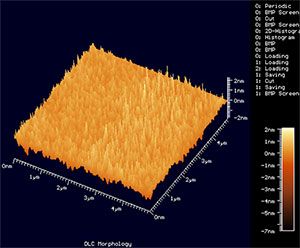
4 um X 4 um Scan of DLC Thin-film on Si Wafer
How DLC is made
Carbon usually exists in several forms; graphite, diamond, and the new form of fullerines. All three of these forms are crystalline in structure but have varying properties based on the bonding order of the carbon atoms. Diamond-like carbon (DLC), on the other hand, is amorphous in structure, containing both SP2 and SP3 bonded carbon. As such, DLC has both diamond-like and graphitic properties. Hence the name diamond-like carbon (DLC).
An AFM scan of DLC Thin-film
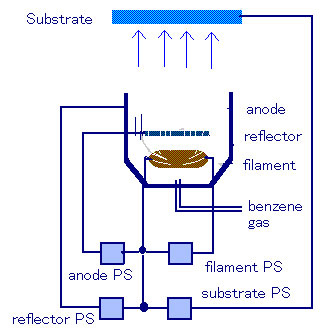
DLC thin-film is produced in the high-vacumn environment inside the Nanocoat 1000 machine chamber by a physical vapor deposition (PVD) process. During the PVD process, benzene is disassociated and ionized by a DC arc discharge (plasma). The resulting ions migrate towards the substrate to be coated which is negatively biased relative to the plasma. Collisions between ions in the gas phase result in the formation of both SP2 and SP3 bonded carbon structures which are then deposited on the substrate surface. As this is a PVD process, no chemistry takes place on the substrate surface and, thus, the substrate temperature can be less than 200° C.
DLC Ion Gun Diagram
Tribological Properties
DLC thin-film has an amorphous structure which is lacking in crystal grains. DLC has a much smoother surface than TiN. Nanotec’s DLC has an average roughness of 7 angstroms whereas a typical TiN film has an average roughness of 110 angstroms. This exceptional smoothness, along with hardness, results in DLC’s superior tribological properties as well as other properties such as wear-resistance, chemical inertness, build-up resistance, and low friction coefficient.
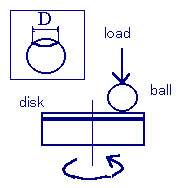
DLC and TiN Thin-films – Roughness Comparison
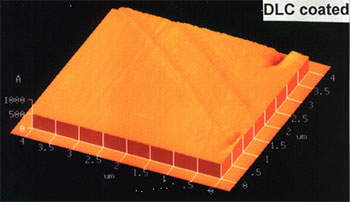
DLC Thin-film on Si Wafer – average roughness: 7 angstroms
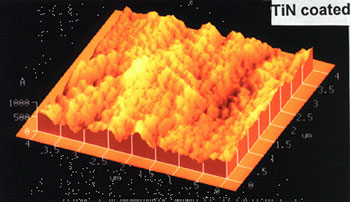
TiN Thin-film on Si Wafer – average roughness: 110 angstroms
The results of a ball-on-disk tribology test is shown below. This test measures the friction coefficient between the ball and coated disk as well as the diameter of the wear spot on the ball. The test consists of rotating a disk which has been coated with the thin-film to be tested under a stationary ball with a given load applied. An aluminum ball was used in this test. The materials tested included WC-Co (uncoated), DLC, TiN, CrN, TiCN, TiAlN thin-films. As shown below, the DLC thin-film out-performed the other materials for both friction coefficient and ball wear.
Diagram of tribology test
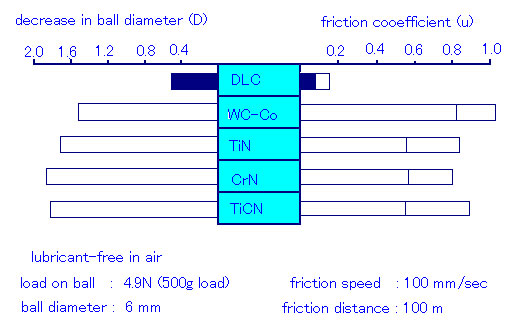
tribology test using aluminum ball
Current DLC Applications Include….
- Aluminum Can Production Tools
- IC Chip Assembly Tools
- WC Press Molds for Ceramics Processing
- Magnetic Tape Recorder Components
- Non-linear Lens Forming Dies
- Blades and Slitters Used for Cutting Aluminum
Custom DLC Thin-film Techniques
In addition to our regular DLC thin-film, we now offer ion implanted DLC (such as Si:DLC or N:DLC) as well as metal-doped DLC (MDLC). All of these DLC thin-films can be produced by our Nanocoat 1000 machine by use of our modular ion-implant and magnetron sputter units. These modular units can be retrofitted to any existing Nanocoat 1000 machine.
Regular DLC Thin-film
single DLC layer
produced by NIS-20 DLC ion source
low friction coefficient
current applications include molds, dies, and moving parts
Ion Implant DLC Thin-film
ion implanted material (Si,N) mixed in DLC single layer
produced by NIS-20 DLC ion source and NMS-40 ion implanter
customization of DLC film for specific applications
current applications include optical lenses and optical components
MDLC Thin-film
metal-containing DLC thin-film, can be multi-layered
produced by NIS-20 DLC ion source and NSP-100 magnetron sputter source
low stress, thick films can be produced
current applications include molds, toothed gears, axial bearings, and moving parts



